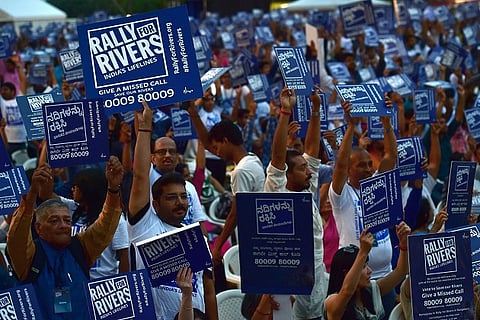

By Vaishnavi Venkatesan
What is Rally for Rivers? It is a campaign launched by Sadhguru of Isha Foundation to raise awareness about the depleting state of India’s rivers. As perennial rivers turn seasonal and smaller rivulets vanish altogether, it is time we take urgent steps to reverse the disaster unfolding before our very eyes. As Sadhguru has said, “Everyone who consumes water must Rally for Rivers.”
Indeed, with its universal message, Rally for Rivers has drawn support from all corners of the country – from environmentalists, farmers, schools and youth, celebrities, corporations and the gamut of political parties. It enjoys the support of Chief Ministers hailing from a spectrum of parties – Karnataka, Kerala, Tamil Nadu as well as BJP-ruled states and the Central Government. As Sadhguru continues his drive across 16 states with 23 major events, this people’s movement will only gain more speed.
To revive the country’s rivers, the campaign proposes bringing in a minimum of 1-kilometer-wide tree cover on river sides and half a kilometer for tributaries. Trees are important in allowing the soil to absorb rainwater and slowly feed the river through natural underground channels. This not only helps prevent floods and soil erosion, it also ensures that the river flows year-round, providing farmers with a continuous water supply even during the dry season. The benefits do not end there. Trees normalize rainfall through a process called transpiration, making rains more predictable for farmers to grow crops.
You may wonder, whether this actually works. Have such experiments been done in the past to bring these benefits? The answer is, yes.
Sample Case Study
After suffering a series of floods and costly damages, a tree-planting project in Yorkshire, UK was initiated. When 50mm of rain fell in 36 hours, the trees showed their worth by reducing the peak river flow. In China, an afforestation project on the Loess Plateau prevented soil erosion, resulting in a 99% drop in sedimentation in the Yellow River. Closer to home in the village of Hesatu in Jharkhand, villagers managed to raise a forest on 365 acres of wasteland. Not only did the agro-forestry initiative make their incomes grow exponentially, it also revived the local Domba River – restoring it from seasonal to perennial. Meanwhile, experts at IISc Bangalore cite examples of how vegetation rich areas like their campus have seen an increase in the groundwater table. This happens because tree roots make the soil porous so that it can absorb water, replenishing aquifers through groundwater recharge.
The solution proposes that riparian (river-side) lands belonging to the government can be made into forests, while agricultural land can transition from cash-crop cultivation to tree-based farming – including fruit trees and horticultural plants. With corporate investment in value-addition industries and financial support to farmers in the initial years, agro-forestry is a proven way to double or even triple farmers’ incomes.
When it comes to water resource projects in this country, this solution stands out. Instead of looking only at managing the water demand through check dams, inter-linking, etc, it is a long-term sustainable solution that looks at source augmentation – increasing the actual quantum of water available for use.
Expert Testimony
A constellation of environment and hydrology experts and organizations are supporting and lending a helping hand to the much-needed campaign, including: eminent Professor T.V. Ramachandra at IISc Bangalore, NABARD, Dr. Rajendra Singh (known as the Waterman of India) and the Fraunhofer Institute in Germany. Isha Foundation is drafting a comprehensive river policy recommendation in collaboration with the Tamil Nadu Agricultural University and various other technical experts and policy makers. It will overview the various obstacles to river restoration, and takes into account the interests of all stakeholders. The draft policy will be presented to the Central Government next month.
Before that, the Rally aims to create awareness and get people’s support to give both the state and central governments the impetus and momentum to implement this long-term policy. The campaign asks citizens to give a missed call to 80009 80009, which will count as their vote to save our rivers. I cast my vote. I didn’t have to think twice about it. For the sake of every human being and every life in this country, I hope you will too.
Views expressed are personal.